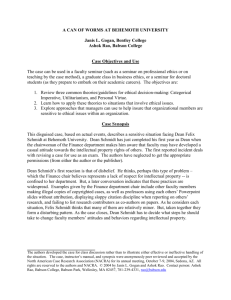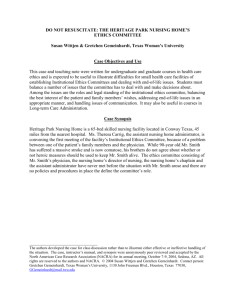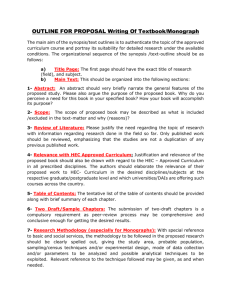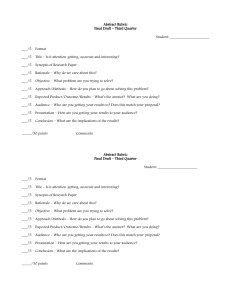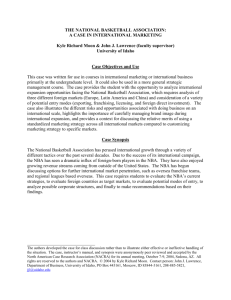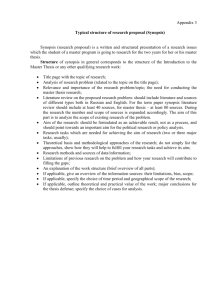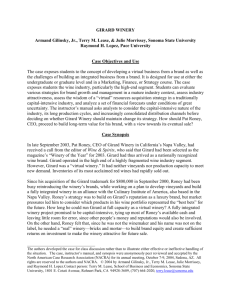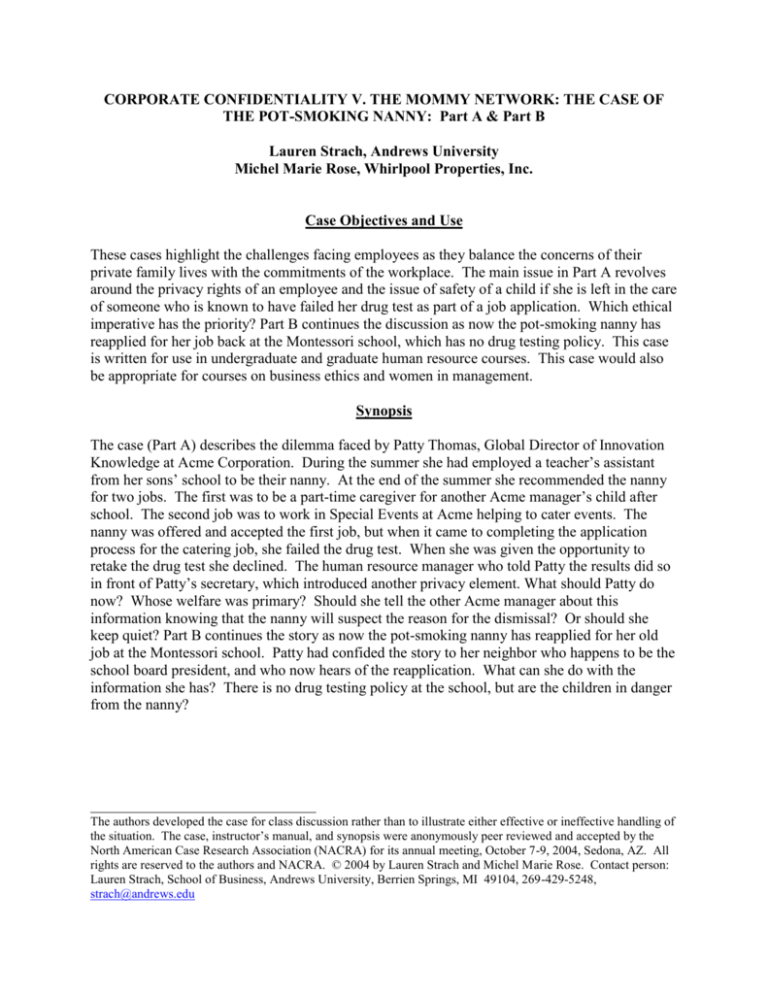
CORPORATE CONFIDENTIALITY V. THE MOMMY NETWORK: THE CASE OF
THE POT-SMOKING NANNY: Part A & Part B
Lauren Strach, Andrews University
Michel Marie Rose, Whirlpool Properties, Inc.
Case Objectives and Use
These cases highlight the challenges facing employees as they balance the concerns of their
private family lives with the commitments of the workplace. The main issue in Part A revolves
around the privacy rights of an employee and the issue of safety of a child if she is left in the care
of someone who is known to have failed her drug test as part of a job application. Which ethical
imperative has the priority? Part B continues the discussion as now the pot-smoking nanny has
reapplied for her job back at the Montessori school, which has no drug testing policy. This case
is written for use in undergraduate and graduate human resource courses. This case would also
be appropriate for courses on business ethics and women in management.
Synopsis
The case (Part A) describes the dilemma faced by Patty Thomas, Global Director of Innovation
Knowledge at Acme Corporation. During the summer she had employed a teacher’s assistant
from her sons’ school to be their nanny. At the end of the summer she recommended the nanny
for two jobs. The first was to be a part-time caregiver for another Acme manager’s child after
school. The second job was to work in Special Events at Acme helping to cater events. The
nanny was offered and accepted the first job, but when it came to completing the application
process for the catering job, she failed the drug test. When she was given the opportunity to
retake the drug test she declined. The human resource manager who told Patty the results did so
in front of Patty’s secretary, which introduced another privacy element. What should Patty do
now? Whose welfare was primary? Should she tell the other Acme manager about this
information knowing that the nanny will suspect the reason for the dismissal? Or should she
keep quiet? Part B continues the story as now the pot-smoking nanny has reapplied for her old
job at the Montessori school. Patty had confided the story to her neighbor who happens to be the
school board president, and who now hears of the reapplication. What can she do with the
information she has? There is no drug testing policy at the school, but are the children in danger
from the nanny?
The authors developed the case for class discussion rather than to illustrate either effective or ineffective handling of
the situation. The case, instructor’s manual, and synopsis were anonymously peer reviewed and accepted by the
North American Case Research Association (NACRA) for its annual meeting, October 7-9, 2004, Sedona, AZ. All
rights are reserved to the authors and NACRA. © 2004 by Lauren Strach and Michel Marie Rose. Contact person:
Lauren Strach, School of Business, Andrews University, Berrien Springs, MI 49104, 269-429-5248,
strach@andrews.edu
THE WACHOVIA CHAMPIONSHIP – 2003
BUILDING THE TEAM
Tim Burson, Will Sparks, & Les Hudson
Queens University of Charlotte
Case Objectives and Use
The primary objective of the case is to illustrate the complex, often competing challenges faced
by tournament director Kym Hougham in regard to building his management team. Students
should be able to identify Hougham’s leadership style, discuss the impact of the diverse
stakeholders, and recognize the key hiring decisions made by Hougham. This case is intended
for upper-level undergraduate students, graduate students, and executive education participants.
Applicable courses would include management principles, organizational behavior, and sport
management/administration.
Case Synopsis
In early May 2002, Tim Finchem, Commissioner of the Professional Golfers Association Tour
(PGA Tour), and Ken Thompson, President and CEO of Wachovia Corporation, announced the
creation of a new PGA Tour Event – The Wachovia Championship. The tournament, which was
to be held in Charlotte, North Carolina, represented the first new PGA spring tour event in 30
years and marked the return of the PGA Tour to Charlotte after a 24-year absence. Kym R.
Hougham was named the Tournament Director. Hougham had been the Director for the John
Deere Classic PGA event for six years prior to the Wachovia Championship. A myriad of
complex, often competing factors created a sense of urgency for Hougham to effectively lead
and manage this event. The tournament’s sponsors set very high expectations. Wachovia was in
the process of a successful merger with First Union and wanted to use this event as a national
platform to communicate their new brand and image. Time constraints, limited staff, and diverse
stakeholders also increased the pressure on Hougham to effectively organize and manage a
difficult event; one that would play out in the national spotlight.
Critical personnel decisions faced Hougham as he began the daunting task of managing a worldclass sporting event. With less than a year to the event, Hougham was the tournament’s only
employee. Key hiring decisions centered on four positions: Sales and Marketing Director,
Operations Director, Volunteer Coordinator, and Tournament Coordinator. Hougham had to
decide on these key positions quickly, finding individuals who would match his style and meet
the very high expectations of the tournament’s sponsor, the community, and the industry.
The authors developed the case for class discussion rather than to illustrate either effective or ineffective handling of
the situation. The case, instructor’s manual, and synopsis were anonymously peer reviewed and accepted by the
North American Case Research Association (NACRA) for its annual meeting, October 7-9, 2004, Sedona, AZ. All
rights are reserved to the authors and NACRA. © 2004 by Tim Burson, Will Sparks, and Les Hudson. Contact
person: Tim Burson, McColl School of Business, Queens University of Charlotte, Box 1420, Charlotte, NC 28274,
704-337-2402, Bursont@queens.edu
THE CHANGING CONSTANT OF LEADERSHIP: KEN THOMPSON, BUD BAKER,
AND WACHOVIA
S. Catherine Anderson, William Sparks, & Robert Finley
Queens University of Charlotte
Case Objectives and Use
This analysis case goes beyond the number-crunching focus of most “M&A” (merger and
acquisition) cases and focuses on the effect of leadership in first conceiving, then executing a
large business combination. The objective is to explore how collaborative, emotionally
intelligent leaders were able to pull off a successful merger (1) recent poor financial performance
and a tough economy, (2) skepticism that a “merger of equals” was possible when one bank was
three times the size of the other, and (3) a perception of divergent corporate cultures within the
two banks.
The case was written for organizational behavior, organizational development, or strategy
courses, and can serve as a capstone experience.
Case Synopsis
When Ken Thompson, CEO of First Union bank, and Bud Baker, CEO of smaller Wachovia
bank, announced a merger of equals on April 16, 2001, the national financial press greeted the
announcement with derision. First Union was reeling from two recent acquisitions gone bad and
had been selling business lines and trimming costs. Just a few months earlier, Thompson, a
young new CEO, had promised his deal-weary shareholders, directors, and employees “no more
mergers.”
On the other side, Wachovia shareholders wanted to know what had possessed CEO Bud Baker.
Market analysts had assumed a deal with Atlanta-based SunTrust was a likely scenario, but the
negotiations had abruptly stopped in December. Now Baker was proposing a low-premium
merger in a deal no one thought would work. At the heart of the issue, the two banks had very
different corporate cultures: one, a risk-taking, merger-happy megalith of national scope; the
other, a customer-friendly, risk-averse, home-town regional bank.
In 2004, Business Week ranked the new Wachovia the best financial services sector company for
creating shareholder value and named Ken Thompson one of the “best managers of the year.”
What made the deal the market analysts ridiculed work?
The authors developed the case for class discussion rather than to illustrate either effective or ineffective handling of
the situation. The case, instructor’s manual, and synopsis were anonymously peer reviewed and accepted by the
North American Case Research Association (NACRA) for its annual meeting, October 7-9, 2004, Sedona, AZ. All
rights are reserved to the authors and NACRA. © 2004 by Catherine Anderson, William Sparks, and Robert Finley.
Contact person: William Sparks, Queens University of Charlotte, 1900 Selwyn Avenue, Charlotte, NC 28274,
704/337-2342, sparksw@queens.edu
DATA RACE, INC.
Clifton D. Petty, Drury University
Case Objectives and Use
This case centers around two streams of executive decision making. The first is the decision to
leave the company’s traditional (and eroding) markets and reposition around a new product
category. The second is a series of change management issues that both drove this repositioning
move, and also emerged as a result of the dramatic shift to a new high technology product.
Based upon these themes, the teaching objectives of this case are to: 1) illustrate the power that
competitive and technological context exerts on the decision making and organizational change
processes; 2) to allow students to use tools from the change management literature to evaluate
the Data Race change effort; and 3) to study the role of executive perception in making strategy
and leading organizational change.
Case Synopsis
Data Race, Inc. was founded in 1983 as a maker of telephone multiplexers. Multiplexers
allowed small companies to increase the capacity of any given phone line. Later, the company
entered the custom modem market, producing laptop modems for such major clients as IBM and
Toshiba. Data Race became a public company in 1992, largely on the strength of its existing
multiplexer and custom modem business.
This case focuses on the period of sweeping change that immediately followed the company’s
IPO. Encroachment from larger rivals hastened the maturity of its multiplexer business, and its
custom modem business began to rapidly evaporate as the computer industry shifted to the
Personal Computer Memory Card (PCMC) platform. Suddenly, Data Race was a public
company without a sustainable business platform.
The company hired Dr. Ben Barker, one of the original developers of the internet, to rebuild and
reposition Data Race. The new CEO quickly designed a new remote access product, and
assembled a talented and diverse team of high technology professionals. In the early 1990s,
telework was forecast to grow rapidly. If Data Race could achieve first mover advantage in this
rapidly growing market, its future looked bright.
This case examines the efforts of Data Race executives to dramatically reposition for cultivation
of a new market, and to transform a company’s culture. The context for these change efforts is a
near perfect storm of technology and market turbulence.
The author developed the case for class discussion rather than to illustrate either effective or ineffective handling of
the situation. The case, instructor’s manual, and synopsis were anonymously peer reviewed and accepted by the
North American Case Research Association (NACRA) for its annual meeting, October 7-9, 2004, Sedona, AZ. All
rights are reserved to the authors and NACRA. © 2004 by Clifton D. Petty. Contact person: Clifton D. Petty,
Breech School of Business Administration, Drury University, 900 N. Benton Av., Springfield, MO 65802,
417-873-7240, cpetty@drury.edu
INAPPROPRIATE WORK BEHAVIOR
Joseph Kavanaugh & Emily Billingsley
Sam Houston State University
Case Objectives and Use
The case shows how the simplest of office interactions can be a human resources minefield. The
teasing of a co-worker turns into a humiliating prank that results in the offended employee
demanding that the prankster be terminated for sexual harassment. While the prankster has a
history of such incidents, none of her prior disruptive, mean-spirited activities were documented
in the exemplary performance evaluations provided by her prior supervisor. The case presents
several issues for students to address: 1. What constitutes sexual harassment? 2. Is sexual
orientation covered under current definitions and court rulings? 3. Could these conditions meet
the tests of a hostile work environment? 4. In the absence of documentation of this employee’s
prior transgressions, what is an appropriate managerial response? Should the employee be fired,
or is a more measured response warranted? The case is attended for use in upper-level human
resource management and management courses at the undergraduate level. However, because
the case is based on a non-traditional sexual harassment claim, it could be used at the graduate
level if particular detail were given to the legal aspects.
Case Synopsis
The case focuses on the actions of Victoria Donavan, IBVP’s top customer service
representative, who has a history of pulling pranks and harassing other employees. When the
case begins, Victoria has decided to “teach a lesson” to a colleague of hers, Brad Keller, for
appearing to be “homophobic”, by placing homosexual personal ads on Brad’s computer monitor
after he has left the office for the day. When Brad discovers what Victoria has done, he claims
that her actions constitute sexual harassment and he insists that the office supervisor, Greg
Howe, fire her as soon as she arrives at work for the day. In analyzing what he should do with
Victoria, Greg remembers several incidents in the past where Victoria behaved inappropriately
and was never reprimanded. Furthermore, Victoria had never received anything but praise on
her performance evaluations, because the former office manager who conducted the evaluations
was only concerned with employees meeting their production goals. The case ends at a major
decision point for Greg. The office supervisor tries to weigh his options and decide upon a fair
and appropriate response as he waits for Victoria to arrive at his office.
The authors developed the case for class discussion rather than to illustrate either effective or ineffective handling of
the situation. The case, instructor’s manual, and synopsis were anonymously peer reviewed and accepted by the
North American Case Research Association (NACRA) for its annual meeting, October 7-9, 2004, Sedona, AZ. All
rights are reserved to the authors and NACRA. © 2004 by Joseph Kavanaugh and Emily Billingsley. Contact
person: Joseph Kavanaugh, College of Business Administration, Sam Houston State University, Huntsville, TX
77341-2056, 936-294-1236, kavanaugh@shsu.edu
THE TATTLE-TALE PERFORMANCE REPORT
John J. Vitton
University of North Dakota
Case Objectives and Use
This disguised case occurred in a research and development laboratory setting. An annual performance report not
only highlighted unusually substandard performance, but eventually identified a mental health condition that
resulted in discharge of the individual. The case illustrates the fact that annual performance reports designed to
weigh effectiveness, promotion potential, and special assignments possibilities may also reveal unintended results,
such as physical and mental disabilities. The case also illustrates the need for a shorter probationary review period
and the use of multiple raters to prevent bias. Also, the use of a reviewing authority is mentioned in the case. This
case can be used in undergraduate and graduate Human Resource Management courses to supplement discussions of
performance appraisal usage.
Case Synopsis
Captain John Gordon reported for duty as Colonel Samuel Startrack’s Executive Officer, in the Air Force Research
and Development Laboratory. “Buzz” Gordon had served as an Executive Officer in a flying organization and knew
that one of the responsibilities associated with that position was reviewing performance reports and drafting
recommended comments for the “reviewing official.” Colonel Startrack was an affable, well-educated senior officer
holding a Ph.D. in the Sciences and a command pilot rating. During the initial meeting of the two officers, Colonel
Startrack emphasized the need for intensive training of civil service and military supervisors on the contents of an
Air Force Manual relating to military performance reports. The Colonel’s concern was triggered by the failed
selection of a highly promising young officer on the Air Force Academy faculty, due to a lack of knowledge of the
amount of inflation in Air Force effectiveness reports. Captain Gordon obtained Air Force-wide inflation rates by
rank, published a conversion chart to add inflation rates to actual performance comparisons, and conducted a
vigorous training program for raters. Shortly thereafter, Captain Plank’s substandard annual Officer Performance
Report was received. Plank was an officer with over six years experience, who was pursuing a Ph.D. Colonel
Startrack asked “Buzz” Gordon to investigate “this hoax”. When the Captain reported the authenticity of the rating,
Colonel Startrack ordered a change of rater and a 90 day probationary report. Receiving the same substandard rating
from the second reviewer and reports concerning bizarre conduct by Captain Plank, Colonel Startrack was
confronted by the need for action. What corrective action needs to be accomplished?
The author developed the case for class discussion rather than to illustrate either effective or ineffective handling of
the situation. The case, instructor’s manual, and synopsis were anonymously peer reviewed and accepted by the
North American Case Research Association (NACRA) for its annual meeting, October 7-9, 2004, Sedona, AZ. All
rights are reserved to the authors and NACRA. © 2004 by John Vitton. Contact Person: John Vitton, College of
Business & Public Administration, University of North Dakota, Grand Forks, ND 5822-8377, 701-777-3229,
john_vitton@und.nodak.edu
REBORN KYOTO NPO (HOUJIN)
Cynthia Ingols & Erika Ishihara
Simmons School of Management
Case Objectives and Use
Reborn Kyoto NPO raises questions about three important organizational issues. The first
revolves around how a nonprofit organization is both helped and hindered by its external
environment. Specifically, Reborn Kyoto case is about a Japanese nonprofit organization that
teaches women in emerging countries dressmaking skills. Since the Japanese nonprofit industry
is not well developed, the founder of Reborn Kyoto faces a paradoxical Greenfield situation,
simultaneous opportunities and constraints. Secondly, the sixty-something founder of Reborn
Kyoto wishes to retire after two decades of work. How does the founder create a succession plan
when she has been the primary force in the organization? Thirdly the case examines how a leader
who is committed to helping less fortunate people also needs to learn how to implement her
vision.
The case was written for and is being used in an organization behavior course. It would also be
appropriate for a course in nonprofit management and international management.
Case Synopsis
After World War II, Masayo Kodama, President, Reborn Kyoto NPO, remembered vividly the
corn and milk given to her and other Japanese that saved them from starvation. A half-century
later, Kodama was determined to help people suffering in distant lands. Kodama developed a
vision: teach impoverished people how to “fish” and they would be able to feed themselves for
life. With this vision, she recruited masterful Japanese seamstresses and traveled to Vietnam and
Yemen. There they taught people how to make patterns, sew, and create clothes that would sale
in Japan and the USA.
Kodama’s mission and “can do” attitude inspired American friends in Boston and Washington
D.C. to sell Reborn Kyoto clothing. Although the sale of products in the US and Japan yielded
revenue for the nonprofit organization, Kodama realized that she lacked the funds to build the
organization and to find a replacement for herself. The case raised a dilemma of a nonprofit
organization: how does a retirement-age founder and visionary leader of a small nonprofit find
her replacement? How does a small nonprofit make sure that it is dotting all “Is” and crossing all
“Ts” as it crosses international boundaries to expand its customer base and sources of revenue?
The authors developed the case for class discussion rather than to illustrate either effective or ineffective handling of
the situation. The case, instructor’s manual, and synopsis were anonymously peer reviewed and accepted by the
North American Case Research Association (NACRA) for its annual meeting, October 7-9, 2004, Sedona AZ. All
rights are reserved to the authors and NACRA. © 2004 by Cynthia Ingols and Erika Ishihara. Contact person:
Cynthia Ingols, Simmons School of Management, 409 Commonwealth Ave., Boston MA 02215.2380,
617.521.3837, cynthia.ingols@simmons.edu
THE IMPACT OF AN ACADEMIC LEADER’S BEHAVIOR IN SARS OUTBREAK
Jingtian Jean Zhu
Long Island Business Institute
Case Objectives and Use
This case reviews events and behavioral issues covering individual, leadership and governmental
levels based on the author’s personal visits and interviews in South China with key doctors and
personnel involved in the 2003 SARS outbreak. While some international public health experts
see quarantine and vaccination as the most important steps needed to contain SARS, this case
tries to show that the SARS threat has been created through human behavior towards certain
animals. One may ask, ”Can an individual behavior, more specifically, a hobby, or preference for
wild animal dishes, shape the environment and thus influence micro-economy, macro-economy
and even the global economy?” “How did an academic leader influence the enactment of statutes
related to a citizen’s personal preference in food?” The case was written for undergraduate
courses in business and environmental management, behavior theories, international business,
health education, and/or government, society, cultural studies.
Case Synopsis
The case begins with the perceptual tracking of the medical record of Mr. Xinchu Huang, a wild
animal dishes chef at a restaurant in South China. Huang, who stepped out of a hospital in
Guangzhou with a charming smile on May 22, 2003, has since been named as “The King of
SARS” by the Chinese media. Huang has been determined to be the source of the 2003 SARS
outbreak that caused 8108 total infection worldwide and 775 total deaths, a fatality ratio of 9.5
percent as per WHO statistics up to June 2004.
Besides describing the source of SARS, the case also presents the foundation competencies,
power, and politics of Dr. Nanshan Zhong, a famous academic leader involved in the outbreak.
Not just leading clinical teams fighting against SARS, Dr. Zhong was also fighting against
Minister Wenkang Zhang of the Chinese Public Health Ministry who was dismissed by the
Chinese Central Government on April 30, 2003 for concealing the outbreak. For long-term
environmental control, Dr. Zhong pushed for statutes related to the raising, transporting, killing
and eating of certain wild animals including civet cats.
The authors developed the case for class discussion rather than to illustrate either effective or ineffective handling of
the situation. The case, instructor’s manual, and synopsis were anonymously peer reviewed and accepted by the
North American Case Research Association (NACRA) for its annual meeting, October 7-9, 2004, Sedona, AZ. All
rights are reserved to the authors and NACRA. © 2004 by Jingtian Jean Zhu. Contact person: Jingtian Jean Zhu,
Long Island Business Institute, 37-12 Prince Street, Flushing, NY 11354, (718) 939-5100 or (718) 358-0303, fax
(718) 939-9235, jzhu@libi.edu
CENTRAL HOSPITAL
Thomas L. Wheelen, University of South Florida
Case Objectives and Use
This case solely focuses on the impact of a single letter written by the personnel director, and
sent to all hospital employees during the early stages of trying to unionize this hospital. The
perception issues between the personnel director and the union organizers over this letter became
crucial in the union process. This letter caused about 90% of the undecided employees to vote
for a union. This was the fourth attempt in four years to unionize the hospital. The hospital was
unionized.
Case Synopsis
Five employees from the laundry and six from the kitchen of the N.Y. hospital formed a
committee to unionize the hospital. The committee felt most hourly employees wanted and
needed union representation for collective bargaining of wages, hours of work, benefits, work
conditions and shift assignments.
Harry Burns, President of the national union, was contacted. He previously was unsuccessful in
unionizing this hospital. He offered his services with no strings attached.
Three members of the committee notified Pete Watson, Personal Director, of the hospital about
their in tensions to unionize the hospital. The committee started the process of getting certified
to hold an election. Several employees complained to Pete Watson about being contacted by
sponsors of the unionization. This led Pete to send out a letter to all employees about the
unionization activities. The committee was upset with lies letter and requested an immediate
meeting, which he postponed until 3:00 pm the next day. The committee and Harry Brown
showed up for the meeting, and Pete was upset with Harry being there.
The author developed the case for class discussion rather than to illustrate either effective or ineffective handling of
the situation. The case, instructor’s manual, and synopsis were anonymously peer reviewed and accepted by the
North American Case Research Association (NACRA) for its annual meeting, October 7-9, 2004, Sedona, AZ. All
rights are reserved to the author and NACRA. © 2004 by Thomal L. Wheelen. Contact person: Thomas L.
Wheelen, College of Business, University of South Florida, 4981 Bacopa Lane S. D301, Saint Petersburg, FL
33715-974-4155, twheelen@stpt.usf.edu
ADVOCATES FIRST
Timothy W. Edlund & Michelle M. Sweeney
Morgan State University
Case Objectives and Use
This case may be used to illustrate the kind of practical difficulties that may arise in making
performance evaluations of employee performance. The student may be asked to critique the
evaluation process, both as to its design as compared to standard theory, and also to its
implementation. Finally, the student can be challenged to develop strategies to overcome the
difficulties, and to reduce their impact in the future.
This disguised case is written for use in courses in Human Resource Management, in portions
dealing with measurement of performance and/or motivation and rewards. It was developed
from personal experience, supplemented with field research, and was researched with the
cooperation of management.
Case Synopsis
Lisa, Program Coordinator for Family Support Services and Respite Care at Advocates First, is
reminded that performance evaluations are due in four days. These evaluations are due,
reporting on weekend respite counselors. Complicating factors include the following: Lisa has
just completed her first three months’ employment; evaluations are to cover a whole year; respite
employees work at a remote site and only on week-ends; Lisa’s scheduled hours are the
conventional nine-to-five, Monday through Friday; and evaluations are due before the next
week-end. No other manager at Advocates First is familiar with work performance of the
employees in question. Moreover, pay raises are determined from performance evaluations, and
non-submission would result in no pay increases for the affected personnel. Competent respite
workers are very difficult to find, particularly since they are considered to be underpaid
throughout the country.
Lisa approaches her immediate supervisor, who makes it clear that Lisa is the only person who
can prepare these evaluations. Lisa wonders how to proceed, given the circumstances.
The authors developed the case for class discussion rather than to illustrate either effective or
ineffective handling of the situation. The case, instructor’s manual, and synopsis were
anonymously peer reviewed and accepted by the North American Case Research Association
(NACRA) for its annual meeting, October 7-9, 2004, Sedona, AZ. All rights are reserved to the
authors and NACRA. © 2004 by Timothy W. Edlund and Michelle M. Sweeney. Contact
person: Timothy E. Edlund, Department of Business Administration, Morgan State University,
1700 E. Cold Spring Lane, Baltimore, MD 21251-0001, 443-885-1687, tim.edlund@toad.net
THE EUROTEL BUENOS AIRES
Cheri A. Young, Alberto Linch, Jessica Zamoyski-Fontenot, & Amy L. McManus
The University of Nevada at Las Vegas
Case Objectives & Use
This case illustrates the challenges of labor management relations, the impact of culture on
international operations, and the complex dynamics of power and politics in a unionized
hospitality context. How should a supervisor deal with an underperforming employee who is
protected from discipline and termination by the union and by fellow workers? How can the
supervisor make effective strategic decisions under the pressure of severe organizational threat
and personal job loss? Instructors can focus students on one aspect of the problem, or allow
them to handle multiple dimensions of the case at once. The case applies concepts found in
organizational behavior, human resource management, labor management relations, international
business, and employment law courses. It can be used with equal success at the undergraduate
and graduate level.
Case Synopsis
Alberto Aliaga is the personnel manager at the Eurotel hotel in Buenos Aires, Argentina. Almost
a year ago, Aliaga hired Ricardo Carrera, a front desk clerk and the newest addition to the team
of 18 employees. After a three-month probationary period of excellent performance, Carrera’s
work behavior was plagued by consistent problems – some of them serious. Because
Argentinean labor laws prevent employers from terminating employees without court approval,
extensive documentation, and severance pay, Carrera was simply kept under close watch.
Carrera soon had enough write-ups for the Eurotel to pursue his termination. Before it could do
this, however, Carrera convinced his co-workers to elect him as the hotel’s union representative.
This role protected Carrera from termination for each two-year term to which he was elected and
for six months afterward. The law also allowed Carrera to devote 20 monthly working hours to
conduct union business at the Eurotel’s expense. After months of filing daily grievances with
Aliaga, Carrera was told to bring all grievances to the front desk supervisor, Carlos de la Fuente.
The next communication that Aliaga received was notice that a union meeting was being called,
and the hotel staff was prepared to strike. Regardless of the outcome, Aliaga would lose his job
if a strike occurred. Carrera could not be fired, and the hotel could not afford to meet the
workers’ list of demands. The general manager was close to retirement, and wanted his
personnel manager to contain and control the situation. Fifteen years after joining the Eurotel at
the age of fifteen, Aliaga was still at a loss about how to proceed.
The authors developed the case for class discussion rather than to illustrate either effective or ineffective handling of
the situation. The case, instructor’s manual, and synopsis were anonymously peer reviewed and accepted by the
North American Case Research Association (NACRA) for its annual meeting, October 7-9, 2004, Sedona, AZ. All
rights are reserved to the authors and NACRA. © 2004 by Cheri Young, Alberto Linch, Jessica Zamoyski-Fontenot,
and Amy McManus. Contact person: Cheri Young, William F. Harrah School of Hotel Administration, University
of Nevada at Las Vegas, 4505 Maryland Parkway, Box 456037, Las Vegas, NV 89154, 702-895-4621,
cyoung@ccmail.nevada.edu


